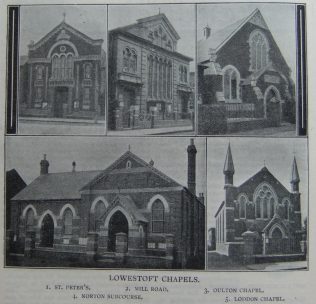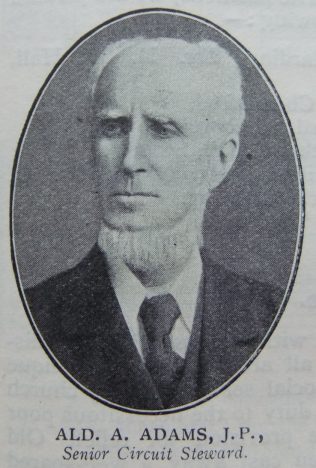Lowestoft Circuit, Suffolk




Transcription of Article in the Christian Messenger by Rev. J.C. Mantripp
Since the days when “Layestof” was a decayed fishing town there has been a resurrection. Its splendid harbour has brought it fame as a haven of refuge; its herring market is noted as the largest in England; and as a fashionable health resort, “lazy, lovely Lowestoft” has been justly called “the Queen of the East Coast watering-places.”
Lowestoft was incorporated as a borough in 1885. The population in 1801 was 2,706; to-day it is over 35,000.
Primitive Methodism in Lowestoft must have had an existence as early as 1825 or 1826. The first preaching-place of which any knowledge can be obtained was a fisherman’s backshed on the beach. It was a dismal spot, paper dipped in oil served the purpose of windows. The window-tax made glass impossible for the primitive finances of those days. But humble though the beginnings were the coming of the Primitives was not unnoticed. Ald. A. Adams, J.P., whose connection with our church in the borough has been life-long, remembers his father telling the tale of rotten eggs coming through the paper windows during preaching and besmirching the preacher. The first chapel erected upon the beach, a square, brick building, seated about 100 to 150 people. Here the work was carried on with varying success until in 1852 the chapel on Whaplode Road (also in the beach neighbourhood) was built. This place, often spoken of to-day by old people who have long ceased to have fellowship with our church as the Ranter’s chapel, was disposed of in 1875 to the Anglican Church and is now used as a net store. The mistake of leaving this part of town has never been retrieved. We have better chapels, and we are needed in all the positions we occupy, but to have left the beach where our church was the only representative of Nonconformity was a wrong step. Some progress has been made since, but not commensurate with the rapid increase in population. In 1870 a chapel was bult at Mill Road, at a cost of £1,222. This is at present undergoing extensive alterations and renovation, and we are anticipating for our society here the new era of success which their diligent plodding deserves. Norwich Road Mission-room was built in 1872 with the intention of erecting a chapel on land in the front. This intention has not been carried out. Indeed a debt still remains upon the present building although this is being gradually reduced. The scholars of the Sunday school fill the place, and a large adult population in this rapidly extending neighbourhood remains untouched by our church. St. Peter’s Street Chapel was built in 1876 to take the place of the old Beach Chapel. This removal involved for a time the loss of our connection with those engaged in the fishing industry, but in recent years we have had the joy of welcoming several “toilers of the deep” into fellowship and our outlook is bright. A new schoolroom was built last year and opened with a balance in hand of £45. The enlargement of the chapel and erection of classrooms is expected to be proceeded with in the autumn of this year. Oulton Chapel was erected in 1903 and is a fine modern building with an aggressive society. In 1852, with a population of 7,580, we had the chapel and 100 members. To-day with a population of 35,000 there are in connection with the three town chapels 172 members. But there are signs of awakening. Brighter days are ahead.
In municipal matters our church is well represented. Ald. A. Adams, J.P., senior Circuit steward (who was in the ministry of our church for two years, but was compelled to retire on account of congestion of the brain), has twice been Mayor. Councs. J. Smith and G. Shadforth are also members of our church. The superintendent minister and Messrs. Adams and Shadforth are members of the Borough Education Committee.
The two chapels contiguous to Lowestoft, Oulton Rock estate and Carlton Coalville, are both within the famous Oulton Broad yachting district. The Oulton Rock Mission-room was erected in 1900 and is now free of debt. The accommodation is altogether inadequate but the pressing needs of extension in the town necessitates a period of “impatient” waiting before the necessary forward movement can take concrete form. Land is already secured for the new chapel. Our Carlton chapel is in the old village nearly two miles away from the centre of population. Here too we must as soon as possible seek to establish a new church.
The story of Primitive Methodism in Loddon is a striking protest against a policy of withdrawal from the village. It is always worth while to plod on apart from any purposed policy of Micawberism. Many village interests have lapsed because the society has been poor, the prospect of immediate success barren, and the attempt to keep things together a constant toil. And the past failure is always the greatest hindrance in the way of any attempt to re-mission these places. Happily in the case of Loddon there were those who could endure in dark days. Previously to 1876 Loddon was on the Norwich Circuit plan. The cause was very low and neglects were so frequent that the chapel must have been closed had not Lowestoft taken it over. From this time an era of prosperity dates. The old debt was liquidated; and preparation made for a new chapel which was opened in 1900. The £1,150. This does not represent the real cost was value of the property. Mr. George Grimson, junior Circuit steward and builder of the chapel, had been storing up the best possible materials for many years. He is justly proud of his work. In the beautiful pitch-pine interior work not a knot or flaw is visible. The debt is reduced to £340. The quarterly contribution to the Circuit fund from this once almost defunct society averages over £11. In 1901 a new chapel and schoolroom were erected at Norton, and preparations are now proceeding for a new property at Hales. Hales is noted in local Primitive Methodist history as the birthplace of the late Rev. John Hammond – a minister of splendid ability whose memory is held in high reverence. Here too he came to die in the old homestead. Here Hugh Bourne preached form the text “Hearken unto me, little children, and I will teach you the fear of the Lord.”
The Rev. Thomas W. Rous, a former superintendent of the Circuit, is a young man still at the advanced age of 90 years. He still takes an intelligent interest in the welfare of the Circuit and although not able to preach is regular in attendance at the morning service at Mill Road.
References
Christian Messenger 1908/27





No Comments
Add a comment about this page